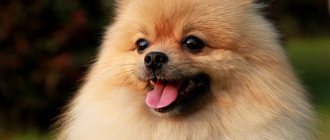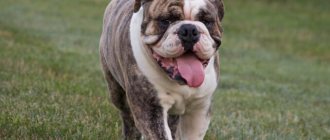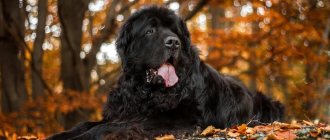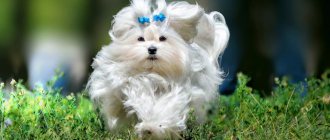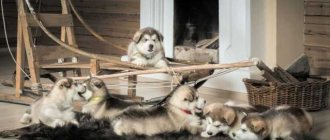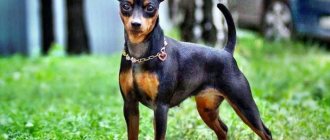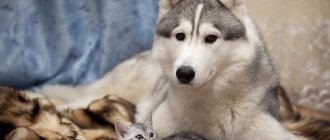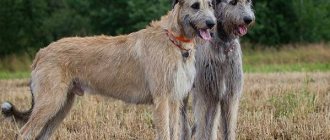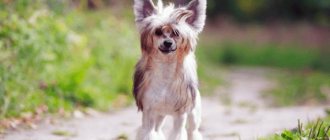The Catahoula dog is an animal with an unusual appearance and character. This variety amazingly combines the qualities of hounds and hunting breeds. Catahoula dogs are valued for their endurance, excitement, hunting instinct, keen sense of smell, agility and pursuit. The “calling card” of purebred representatives of the selection is their unusual coat color - leopard.
The dog needs an owner with a strong and fair character, who wants to have an excellent companion, a loyal friend and a sensitive game hunter nearby.
Description and features
The appearance of the Catahoula leopard dog (hereinafter referred to as Catahoula) creates the impression of an agile and hardy animal. They are usually medium or large in size (depending on the breeding line). There should be no excesses in the figure, neither heaviness nor excessive lightness.
Strong, moderately lean and harmonious physique. By the way, the appearance of a dog is assessed from the point of view of its influence on its working qualities. She was bred for her temperament and ability rather than her appearance. Therefore, the sizes of these dogs can vary significantly, with boys always being larger than girls.
Height ranges from approximately 51 to 66 cm, weight from 18 to 51 kg. A properly built dog is longer than tall. The spine is strong, the loin is slightly arched. The chest is moderately wide, the croup is slightly sloping. The head is large, but not excessively, in accordance with the size of the body. The jaws are strong, with a scissor bite.
The coat should be short or medium length, and can be soft to the touch or rough. Single coat, without undercoat, close to the body. When describing the appearance of a Catahoula , special attention should be paid to the eyes. When you look at them, they literally take your breath away. They fascinate and freeze.
The eyes are one of the most interesting elements of this breed. Their color can be a shade of "cracked glass" or "marble glass". This happens with heterochromia (eyes of different colors or different colors of different parts of the iris in one eye).
Cracked glass or marble eyes that are Catahoula blue or blue-white are often called "double glass eyes." They may have both dark and lighter areas. There is a division in half on one iris - half of one color, half of another. Sometimes there is simply a stripe or spot of a different color.
Gray eyes, for example, are marked by blue and green areas, which create the gray color. The eyes can be the same color, or there can be two different eyes. In general, a kind of mosaic picture that is not always predictable. There is no specific standard, there can be gray, green, blue, light blue, amber, brown colors in different combinations.
The tail is often long and can reach the hock joints. Sometimes, on the contrary, it can be a shortened bobtail type (length from one to three vertebrae in total length). The long one is usually curved at the bottom in the shape of a question mark - a distinctive feature of the Catahoula tail. There is often a white tip on the tail. Short tails are a genetic heritage of the breed and are very rare.
The legs of the Catahoula are slender, quite long, and have a pronounced membrane between the toes. This makes it easier for them to hunt in the swamp and gives them the opportunity to swim well. The Catahoula leopard dog in the photo is very beautiful. Gracefulness, innate nobility, beautiful coloring and unusual crystal eyes - all this makes the breed memorable and desirable.
Hunting hounds
The largest number of hunting breeds belongs to the hounds. They can run after game for up to hundreds of kilometers without getting tired, and are widely used for baiting.
Basset Hound
Bassets come from England, are small in size, weighing up to 30 kg. They are persistent and can chase an animal for a long time, although they are not able to develop great speed. An excellent sense of smell allows you to find the animal again even if you lose sight of it. Bassets are usually taken for hunting on foot.
Austrian Hound
This dog has short black hair and a muscular body. She jumps high, is resilient, can run for a long time, and is not afraid of any animal. Widely used only in Austria; in other countries it occurs in isolated cases.
Beagle
English Beagle puppies are incredibly cute, beautiful - white with large black and brown spots on their backs. Dogs have keen eyesight, an excellent sense of smell, they are hardworking and resilient. Hunting requires preliminary training in the form of a game.
Bloodhound
A dog of this breed will feel the “aroma” of the wanted animal even after 10 days. She is good at pursuing, especially wounded animals, as her name suggests (derived from the word “blood”). The downside is stubbornness, so you will have to persistently train the dog. It is best to use a diarrhea with glued feathers or animal down.
Finnish hound
A powerful dog originally from Finland, it is widely used for baiting hare and fox. She picks up the bird and chases it towards the hunter. The breed can be used even in harsh climates; it has a dense undercoat, although the dog does not really like winter walks.
Drever
Drever (Dachsbrak) is a Swedish short-legged hound, resembling a dachshund in body shape. At home she is kind and gentle, but on the hunt she is daring and brave. Used for catching roe deer, hare, fox, wild boar, works alone or in a group. The dog drives the animal towards the hunter. The downside is the low speed.
Rhodesian Ridgeback
Bred in South Africa, distributed throughout the world. Initially used to catch lions, it is suitable for any large animal. The dog is strong, muscular, very hardy and courageous. Can be used as a security guard.
Dalmatian
The recognizable breed is black and white, spotted. Can hunt down any prey thanks to its stamina. It has a difficult character and will require patience to train. With the wrong approach, the Dalmatian will frighten the game, but not drive it, although after training it will gladly bring it to its owner.
English Foxhound
Designed for catching foxes, it also hunts hare well. Usually works in a group of relatives, but alone it will become an assistant to the hunter. Training is carried out strictly, otherwise the animal quickly begins to be lazy.
American Foxhound
It is an excellent beater of wild boars and foxes. No less dexterous when hunting raccoons, pumas and even bears. The American Foxhound is able to work in the cold, is hardy, but stubborn, and requires a long training period.
Veneri
Small Anglo-French hounds that cannot exist for a long time without hunting walks. The reaction is fast, the strength is high, the animals are suitable for driving small and large animals. Show excellent results on any terrain.
Kinds
Catahoulas come in a variety of colors including blue merle, red merle, brindle and solid colors. Merle is a coat with uneven coloration in the form of dark and lighter areas of the same color. The result is a “marbled” look. Sometimes the more permanent color is "sprinkled" with patches of other colors, such as white patches on the chest, legs or face.
Actually, the “merle” gene is responsible for the “leopard” color of the dog. Moreover, it happens that it manifests itself especially clearly not on the entire coat, but in certain places. We will present to you the most popular colors of the Catahoula dog, although we repeat that coat color is not a priority when choosing a dog; it does not affect its quality in any way.
- Red Leopard - Various shades of brown, sometimes with small white spots. Known as "red merle".
- Blue leopard - various shades of gray, from light to black, sometimes with rare white spots. Known as "blue merle".
- Black or black leopards are the least affected by the merle gene, but still have blue or gray spots.
- Gray or silver leopard is a blue leopard where the black color has been diluted to gray. Known as "merle slate".
- Tri-color - usually three colors are involved - black, gray, white.
- Four-color or five-color - dogs with different colors, brown and blue of different shades are added to the three main colors.
- Patchwork are predominantly white dogs with a small amount of merle spots throughout their coat. They can be black and brown. If you breed these merles further, you can achieve grey, blue, red or liver colors in them.
In addition to colors, it is appropriate to talk about the breeding lines of this breed, on which the size of dogs of this breed depends. There are three similar lines:
- The Wright line is the largest line of Catahoulas, weighing 40 to 50 kg, and was designed by Perston Wright. This line were specimens originally produced from dogs that arrived with Hernando de Soto (16th century Spanish conquistador, conqueror of the New World).
- The Fairbanks line is the next largest, weighing 30-35 kg. Was developed by Mr. Lavi Fairbanks. They were different shades of yellow, including brindle.
- McMillin Line. This blue glass-eyed Catahoula, measuring approximately 50 pounds, was developed by Mr. McMillin of Sandy Lake, Louisiana.
These three lines were the progenitors of all variations of Catahoulas known today.
Feeding
This rare dog is not capricious and picky about food, so the owner can decide for himself what he will feed his pet - ready-made industrial food or natural food
In the first case, products ranging from super-premium are purchased; it is important to provide the pet with round-the-clock access to clean water
In the second, food is prepared in a separate pan individually for the dog; it is unacceptable to give it the same thing that the owner eats. It is difficult to provide your pet with all the necessary vitamins and minerals in natural form with this feeding option. Therefore, the animal is additionally given ready-made complexes. A veterinarian can help you choose a specific vitamin name.
You can give your dog:
- Boiled or raw, but pre-frozen lean meat.
- Offal (heart, liver, kidneys).
- Sea fish (necessarily cleaned of scales and bones).
- Vegetables and fruits as sources of vitamins.
- Porridge.
Note! Meat should make up 70% of the diet. You should not give your pet cheap, economy-class food, even occasionally. The Catahoula gastrointestinal tract is not adapted to digest them, so the risk of problems with the digestive system increases
It is also unacceptable to treat your dog with sausages, frankfurters, sausages, cutlets and other human delicacies. Sweets, pastries, pasta, soups prepared with salt and spices are also prohibited. And, of course, alcohol - it should not be given even in tiny quantities.
Catahoula's gastrointestinal tract is not adapted to digest them, so the risk of problems with the digestive system increases. It is also unacceptable to treat your dog with sausages, frankfurters, sausages, cutlets and other human delicacies. Sweets, pastries, pasta, soups prepared with salt and spices are also prohibited. And, of course, alcohol - it should not be given even in tiny quantities.
You should not give your pet cheap, economy-class food, even occasionally. Catahoula's gastrointestinal tract is not adapted to digest them, so the risk of problems with the digestive system increases. It is also unacceptable to treat your dog with sausages, frankfurters, sausages, cutlets and other human delicacies. Sweets, pastries, pasta, soups prepared with salt and spices are also prohibited. And, of course, alcohol - it should not be given even in tiny quantities.
The look of Catahoula touches the soul, the owner is ready to give the dog his favorite treat at least every hour
History of the breed
The exact origins of the Catahoula leopard dog are unknown. And as always in such situations, there are several theories. The first is the crossing of Molossian dogs (large individuals native to Molossia, a region of ancient Epirus) and greyhounds, which appeared in Louisiana with the Spaniards in the 16th century.
The second theory is that the breed originated much later, in the 19th century, after the French brought the Beaucerons (French shepherd dogs, an ancient and rare breed) to America. And the leopard dog supposedly came from crossing Beaucerons and red wolves. Although it is a little unclear, because almost at the same time the French had already seen strange-looking dogs with transparent, glass-like eyes, which were used by the Indians to hunt game in the swamp.
The third theory claims that it was the result of crossing indigenous dogs of local Indians with red wolves (hybrids of the gray wolf and coyote, native to America, which have practically disappeared and are listed in the Red Book). But this theory is not supported by modern DNA analysis.
Be that as it may, in 1979 the government of Louisiana declared it the official state symbol in recognition of the importance of this breed in the history of the state. A dog of “noble Louisiana origin” recalls the prosperity of this state.
Peruvian Inca Orchid
An ancient breed from Peru.
Outwardly, it is very similar to the Mexican naked, they are often confused. It is distinguished by a more graceful constitution - the Peruvian dog does not have such a powerful chest, although it is larger than the Mexican dog in size and weight. It is also characterized by the presence of bald and woolly individuals, although the breed standard for bald individuals includes the presence of hair on the head and paws. Also, the presence of spots on a plain skin or coat is not an indication for culling.
Did you know? In Peru, the hairless Inca dog (other names calato or viringo) is recognized as a national treasure. The ancient Peruvians believed that it could cure diseases. This belief was largely caused by the unusual appearance of this dog and its elevated body temperature.
The breed has only recently begun to revive, so export abroad is difficult at the legislative level.
By nature, this is a companion dog, affectionately attached to its owner, but distrustful of others. A very territorial dog, he protects the boundaries of the house.
Interesting properties to keep in mind if you are going to get an orchid are that it sweats through its skin (unlike most dogs, which regulate their temperature using their tongue) and is active at night, so it is not very suitable for pronounced larks.
Character
Catahoulas are very intelligent and energetic. They are persistent and devoted, sociable but not intrusive, active and playful. At the same time, intelligent and balanced. Moreover, they are curious, independent, loving and gentle. The character of the Catahoula leopard dog can be described in a phrase: it clearly divides people into “friends” and “strangers.”
May sometimes show intolerance and some aggression towards strangers and other dogs. The Catahoula may seem somewhat withdrawn at the first meeting, but will never show cowardice. Sometimes she can suddenly remember her hunting instincts and attack domestic animals - chickens or cats, even if she grew up next to them.
To avoid this, you need to raise your puppy on time and correctly. After all, temperament manifests itself if classes are conducted with her in such an aggressive direction. And the Catahoula has a very receptive disposition; they easily learn both good and bad.
Most dogs get along very well with children and protect them at the slightest danger. Moreover, they love children as a fact, even strangers. But adults who are not from “their pack” are always feared and kept on guard with them. Despite many advantages in character, they can be stubborn and insubordinate. This can also be avoided by showing your leadership as a leader.
In no case should you show violence; the dog has a good memory and enough self-esteem. In the future, she will lose trust in you, which means there will be no friendship with devotion either. Only consistent education.
It is necessary to conduct classes and educate the dog from an early age so that it is socially adapted. With proper, non-aggressive upbringing, you can achieve the maximum elimination of negative qualities in character. Let us remember that their original purpose is to hunt wild boar, deer, raccoons, as well as to help with grazing livestock.
When hunting, they usually stalk their prey silently and only begin to bark next to it. They restrain the animal without going close to it, using only barking and an aggressive message. When grazing cattle, they are used to maintain discipline and some intimidation in the herd.
Catahouls are often used in search and rescue services, as well as in dog sports. But many people keep these wonderful dogs as a family member, friend and companion. To summarize, we can confidently say: the Catahoula leopard dog is a universal breed.
Characteristics
| Attachment level | Average |
| Friendliness | Average |
| Child Friendly | Average |
| Loyalty to other pets | Low |
| Exercise needs | High |
| Playfulness | High |
| Energy level | High |
| Learning ability | Average |
| Intelligence | Average |
| Tendency to bark | High |
| Shedding amount | Average |
Nutrition
The diet consists of 70-80 percent lean meat. Next on the menu you should include vegetables, cereals, dairy products, and eggs. Potatoes and pasta can be given no more than 2 times a week. If you feed natural food, add some vegetable oil for vision, as well as essential vitamins and minerals. You can choose ready-made food for active dogs.
Only preferably “premium class” or “holistic” (based on natural products). The necessary nutrition is already balanced there. Small puppies are fed 3-4 times a day, adult dogs - 2 times a day. There is no need to spoil your pet with food from your table, especially sweets, baked goods, smoked meats and canned food. They negatively affect the dog’s stomach and can lead to illness. Fresh fresh water must be available.
What to feed?
There are no special recommendations for feeding representatives of this breed. Of course, the diet should be complete and balanced according to BJU. Food is selected taking into account the age of the pet
You should pay attention to ready-made super-premium dry food designed for dogs with an active lifestyle.
Natural feeding is also allowed. In this case, the pet’s menu must include meat and offal. The proportion of such components is calculated as follows: 40 g per 1 kg of weight for young individuals and 10-15 g per 1 kg of weight for adults. The animals are also given cereals, eggs, and vegetables. Fermented milk products are also useful.
Reproduction and lifespan
First of all, do not forget that this is a very extraordinary dog and a novice dog owner should not get this breed. However, Catahoula leopard dog puppies are so adorable, they have such beautiful fur and such unique eyes that it’s hard to resist. Therefore, we give the most important advice: you should not combine two merles when breeding.
Despite the fact that the parents will be very beautiful, the children may turn out to be unfortunate cripples - deaf, blind or with other genetic diseases. Even if their health is fine, they may grow up uncontrollable, aggressive, or, on the contrary, fearful.
In a word – genetics doesn’t dictate! The “daughter of Catahoula” is usually brought to the groom for mating; it is more convenient when the male is on his territory. There are 5-6 puppies in a litter. Everyone can turn out different colors. The color of the coat is the individual passport of the dog. The average life expectancy is approximately 11-14 years.
How to choose a puppy
Outside of its historical homeland, the Catahoula breed is practically not bred. There are more than 20 kennels in the United States that professionally breed leopard dogs.
You will have to make arrangements in advance to purchase a purebred Catahoula. Before purchasing an animal, pay attention to the puppy's fur and behavior. Shiny fur, glowing eyes and a playful mood are signs of healthy offspring. If the puppy behaves shyly in your presence, hides and does not show interest, it is better not to adopt such a pet.
A good Catahoula puppy has a large build, proportional shape and correct coat color.
Care and maintenance
Caring for the beauty's short hair is easy. It is enough sometimes, about once every seven days, to wipe it with a damp towel or just with your hand, which will be much more pleasant for the dog. Sometimes you can massage with a hard mitten. With this you will remove excess hair and scratch your pet’s sides.
During the molting period, combing procedures should be carried out more often - 2-3 times a week. General recommendations, as for many dogs, are teeth, eyes, ears. Everything needs to be cleaned regularly. It is recommended to trim the nails if they do not wear down naturally. It is not recommended to keep a dog in an apartment, preferably in a private house, where there is an opportunity to spend a lot of time in the fresh air.
The ideal option is to live somewhere on a hunting property or on a farm. Where there is a job for her intended purpose. However, if you have a lot of time to walk with her for a long time, perhaps she will find it cozy in the apartment. They need to be occupied with gymnastics, training, and learn various commands.
By the way, they are big fans of digging in the yard. Stop such “exercises”, otherwise your entire territory will be in pits. And one more piece of advice - they don’t really like cold winters, because their fur is short, so it’s worth taking this factor into account.
Only a person who has some experience in cynology should own such a dog. Therefore, it is recommended to immediately contact an experienced professional. They have some health problems:
- Deafness is a genetic predisposition, usually affecting white dogs, and is associated with the presence of melanocytes in the body. Therefore, when choosing a dog, you need to make sure that there is some white in the color. These dogs have an 80% chance of being deaf or with one-sided hearing (directional deafness). Breeders euthanize deaf puppies. If both parents are Merle, their children have a 25% chance of being blind, deaf, or both. These puppies are called "double merle".
- Hip dysplasia is also a genetic disease, and also depends on the responsibility of the breeders. According to the Animal Orthopedic Foundation, approximately 20% of Catahoulas have this disease. It is necessary to take an x-ray on time and undergo an examination by a doctor.
Dogo Argentino
- Height: from 60 to 68 cm
- Weight: from 35 to 45 kg
- Life expectancy: 10 to 15 years
You might be surprised to find a Dogo Argentino on our list, especially since many of these dogs spotted are completely white. However, they do have the piebald gene, which can cause spots to appear on their coat from time to time.
For the most part, Dogo Argentinos may only have one spot, usually on the eye. Otherwise, these dogs are predominantly snow-white from nose to tail.
As the name suggests, this breed originates from Argentina, where it was bred to hunt large game. Throughout its history, the Dogo Argentino has had a bad reputation, based mainly on its involvement in bloody fights and ferocious fights with wild animals.
However, the modern Dogo Argentino is a relatively gentle, friendly, patient and affectionate dog that can get along well with a wide variety of owners if it is properly raised, trained and socialized.
Price
First, let's introduce the disqualifying qualities of this breed:
- Excessive aggression or extreme shyness.
- Unilateral/bilateral cryptorchidism (not descending of the testicle into the scrotum, location of the testicles outside the scrotum).
- Unilateral/bilateral deafness.
- Long and/or fluffy coat.
- More than 90% white; completely white head; albinism (completely white);
- Complete absence of tail;
- Cropped ears.
The dog you choose should not have all these shortcomings. This breed is quite rare outside its homeland, so it is necessary to choose a reliable nursery or a trusted breeder.
Catahoula leopard dog kennels are located mainly in America, Germany, the Czech Republic and some other countries. The price of a Catahoula leopard dog officially starts at $1,000, although in fact many kennels offer no less than $1,200.
Don't forget about shipping costs. Taking into account all expenses, a dog can cost you 1500-1600 dollars. It would not be superfluous to remind you that when purchasing, you should check all the documents for the dog, including the colors of the parents, and the presence of vaccinations.
Historical reference
There is no exact information about the origin of the breed yet, but many myths and legends are associated with the Catahoula dog. There is a belief that in ancient times these dogs accompanied the Choctaw Indians who lived on the shores of Lake Catahoula. That is why the breed got its name, which translates as “clean lake”.
The Louisiana Leopard Dog is a charming pet with a difficult temperament.
Note! It is believed that the name of the breed was given in honor of the amazing sky-colored eyes of these dogs. The first written mention of the breed dates back to the 16th century. Modern dogs are the result of a complex crossbreeding of aboriginal representatives and French herding Beaucerons
At the beginning of the 20th century, the breed was brought to the brink of extinction, but through the efforts of breeders it was saved. In 1951, fans of the breed founded the National Louisiana Catahoula Dog Association. A breed standard was formulated, and since 1979 these dogs have taken part in international exhibitions. However, they have not yet received recognition from the International Canine Federation
Modern dogs are the result of a complex crossbreeding of aboriginal representatives and French herding Beaucerons. At the beginning of the 20th century, the breed was brought to the brink of extinction, but through the efforts of breeders it was saved. In 1951, fans of the breed founded the National Louisiana Catahoula Dog Association. A breed standard was formulated, and since 1979 these dogs have taken part in international exhibitions. However, they have not yet received recognition from the International Canine Federation
The first written mention of the breed dates back to the 16th century. Modern dogs are the result of a complex crossbreeding of aboriginal representatives and French herding Beaucerons. At the beginning of the 20th century, the breed was brought to the brink of extinction, but through the efforts of breeders it was saved. In 1951, fans of the breed founded the National Louisiana Catahoula Dog Association. A breed standard was formulated, and since 1979 these dogs have taken part in international exhibitions. However, they have not yet received recognition from the International Canine Federation.
Interesting Facts
Here are some unusual features of Catahoula dogs:
- They have an amazing memory, but are stubborn. Therefore, the fight against behavioral defects should begin at an early age.
- Puppies mature quickly and at 9 months they become similar in appearance to adult dogs.
- They are just as quickly able to engage in the activities intended for them. Catahoulas are universal dogs, suitable for hunting, guarding, and being a companion - they approach everything responsibly.
- They love to swim and do it well thanks to the membranes between their toes.
Amazing color and stunningly beautiful blue eyes are the strengths of this breed.
Interesting Facts
- Sometimes this breed of dog is said to be “the fiend of hell.” They mainly earned this nickname because of their unusual icy eyes. But not only. In pursuit of the beauty of the “leopard” coat, unscrupulous breeders crossed merle dogs indiscriminately, resulting in puppies with a very unstable psyche, angry and uncontrollable. But they were not to blame for this, people spoiled them.
- It is known that Theodore Roosevelt, the 26th President of the United States, had great respect and trust in the Catahoula breed. He only used them when hunting and often fell asleep with this dog at his feet.
- In Winnfield, Louisiana, an event featuring the Catahoula Leopard Dogs is held annually on the third weekend in March. They are called "Uncle Earl's Hog Dog Test." In addition to leopard dogs, other hunting dogs take part there. Uncle Earl is one of the most famous governors of Louisiana, Earl Kemp Long, who lived in the early 20th century. He was an avid hunter and promoter of the Catahoula Leopard Dogs.
- In 2007, the Catahoula was adopted as the school mascot for Louisiana Centennial College.
- Catahoula is a dog for tracking and keeping in place the prey. She does not go into a direct attack, since often the hunted animal can be much larger than her. Therefore, Catahoula bulldogs appeared in Australia and the southern United States - a breed resulting from crossing hunting dogs and American bulldogs. This dog has the best qualities of both breeds. He is capable of both tracking and attacking.
Gallery Edit
| Dog breeds |
| Australian Short-tailed Cattle Dog • Australian Shepherd • Australian Heeler • Australian Cattle Dog • Australian Kettle • Australian Terrier • Azawakh • Aidi • Alabai • Alano • Alpine Dachshund • American Water Spaniel • English Bulldog • English Coonhound • English Springer Spaniel • Appenzeller Mountain Dog • Affenpinscher • Greater Swiss Mountain Dog • White Swiss Shepherd • Barbet • Bergamasco Shepherd • Bichon Frize • Beauceron • Catahoula Bulldog • Buryat Mongolian Wolfhound • Welsh Corgi • West Highland White Terrier • East European Shepherd • Havanese Bichon • Gampr • Dutch Smoushond • Blue Gascony Basset • Dalmatian • Dandie Dinmont Terrier • Doberman Pinscher • Longhaired Collie • Drathaar • Eurasier • Wire Fox Terrier • Golden Retriever • Irish Water Spaniel • Yorkshire Terrier • Cane Corso • Kerry Blue Terrier • Cairn Terrier • Cromforlander • King Charles Spaniel • Shorthaired Collie • Komondor • Kuvasz • Kurzhaar • Labrador Retriever • Langhaar • Lhasa Apso • Mallorcan Shepherd • Maltese • Miniature Schnauzer • Pug • Moscow Watchdog • German Boxer • Auvergne Pointer • Otterhound • Puggle • Pekingese • Pyrenean Shepherd • Poodle • Puli • Pumi • Samoyed • Saint-Germain Braque • Slovakian Dude • Dachshund • Husky • Hovawart • Croatian Shepherd • Miniature Schnauzer • Chinook • Chihuahua • Swedish Lapphund • Shih Tzu • Sheltie • Sholoitzcuintle • Entlebucher Mountain Dog • Estrela Shepherd • Jagdterrier • Japanese Chin |
Work
Hunting
Catahoulas are used as bay dogs, tree dogs, and for hunting a variety of game, including small game such as raccoons and squirrels, as well as large game such as deer, mountain lions, and bear. They are also used for scent detection and as a search and rescue dog.
Herd
Catahoulas have a natural herding instinct and a unique way of working with the herd. The AKC describes this as creating a "dog fence" around the herd, which allows the dog's owner to control the herd within that circle. Herding ability and natural working instinct are the highest priority for Catahoula breeders, besides the dog's appearance. Herding instincts and learning ability can be measured using non-competitive tests. Catahoulas exhibiting basic herding instincts can be trained to participate in cow/pig trials.
References
- Abney, D. (2011). Full leopard dog Louisiana Catahoula. Bloomington, IN: AuthorHouse. Page 9
- Laney, Ruth (24 August 2015). "The Catahoula Connection." Country Roads Magazine
. - "Catahoula Leopard Dog." American Kennel Club
. Retrieved November 26, 2022. - ^ a b c d f
"Breed Standards: Louisiana Catahoula Leopard Dog."
United Kennel Club (UKC)
. - ^ a b c d
"Information on the Catahoula Leopard Dog Breed."
American Kennel Club
. - Mehus-Rowe, C. (2005). The Original Dog Bible (p. 206). Irvine, CA: BowTie Press.
- Mehus-Rowe, C. (2005). The Original Dog Bible
. Irvine, CA: BowTie Press. p.206. - Mehus-Rowe, C. (2005). The Original Dog Bible
. Irvine, CA: BowTie Press. p.206. - "Double Merle." Genetics of dog coat color
. - "Coat colors." National Louisiana Catahoulas Association
. Retrieved August 12, 2022. - "Information about Catahoula" Questions about Catahoula "Coat". Abney Catahoulas
. Retrieved August 12, 2022. - “National Association of Louisiana Catahoulas, Inc. Breed standard." Archived from the original on 2017-10-16. Retrieved 2017-10-15.
- "Catahoula's Coat of Problems."
- "Catahoula's Coat of Problems."
- "Examples of eye color." National Louisiana Catahoulas Association, Inc.
. Retrieved November 26, 2022. - Abney, Don. "Catahoula Questions, Catahoula FAQs." Abney Catahoulas.
- "Best Hunting Dogs for Finding, Pointing, Flushing or Sniffing." Outdoor Life
. 2019-10-30. Received 2019-11-20. - "Catahoula Working Dog." EALC
. Received 2019-11-20. - Hartnagle-Taylor, Jeanne Joy; Taylor, Ty (2010). Stockdog Savvy
. Alpine Publications. ISBN 978-1-57779-106-5. - Young, Linda (18 May 2010). "Information on the Catahoula Leopard Dog Breed." 2Hals Pharm. Archived from the original January 14, 2012. Retrieved April 5, 2009.
- Abney, Don. "Information about Catahoula." Abney Catahoulas.
- Strain, G. N. Deafness and the Merle gene. Louisiana State University.
- Abney, Don. "The History of Catahoula: A Factual Account of the Origin of Louisiana Catahoula." DonAbney.com
. Self-published. - ^ a b c
"History of Catahoula." Burglar Catahoulas. Archived from the original on 2009-06-23. Retrieved 2018-12-08. - "Centennial College Unveils New Mascot." Louisiana Centennial College. December 7, 2007. Retrieved August 13, 2019.
Job
Hunting
Catahoulas are used as bay dogs, tree dogs, and for hunting a variety of game, including small game such as raccoons and squirrels, as well as large game such as deer, mountain lions, and bear. They are also used for scent-catching and as a search and rescue dog.
Herd
Catahoulas have a natural herding instinct and a unique way of working with the herd. The AKC describes this as creating a "dog fence" around the herd, which allows the dog's owner to control the herd within that circle. Herding ability and natural working instinct are the highest priority for Catahoula breeders, in addition to the dog's appearance. Herding instincts and learning ability can be measured using non-competitive tests. Catahoulas exhibiting basic herding instincts can be trained to compete in cow/pig trials.

